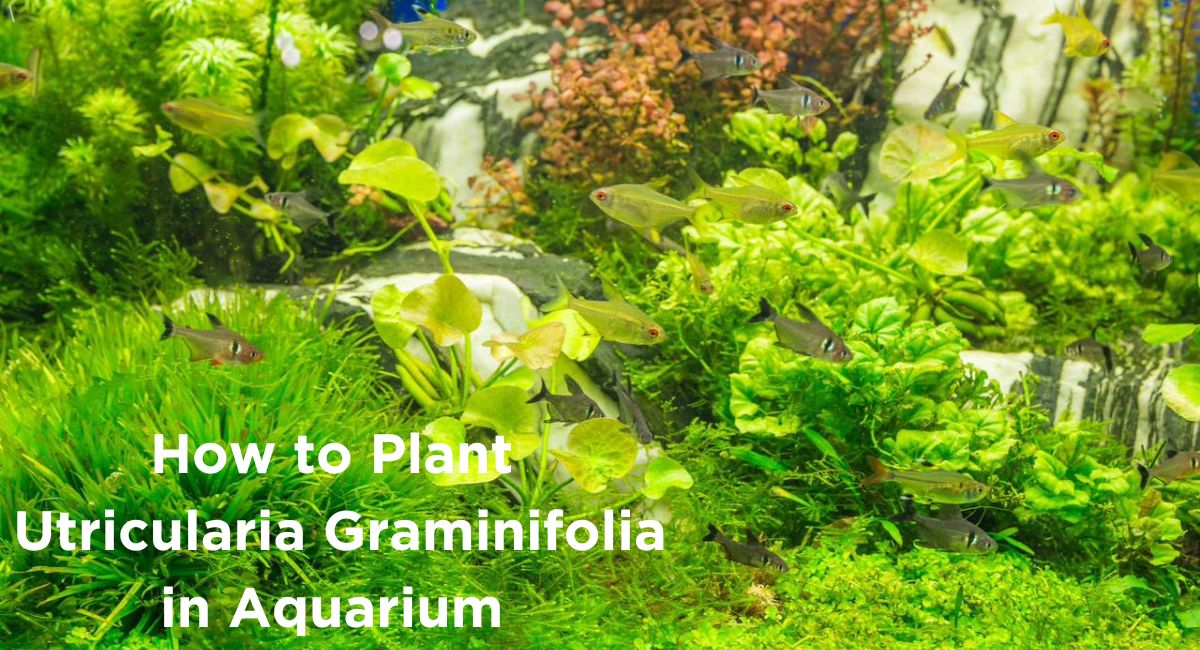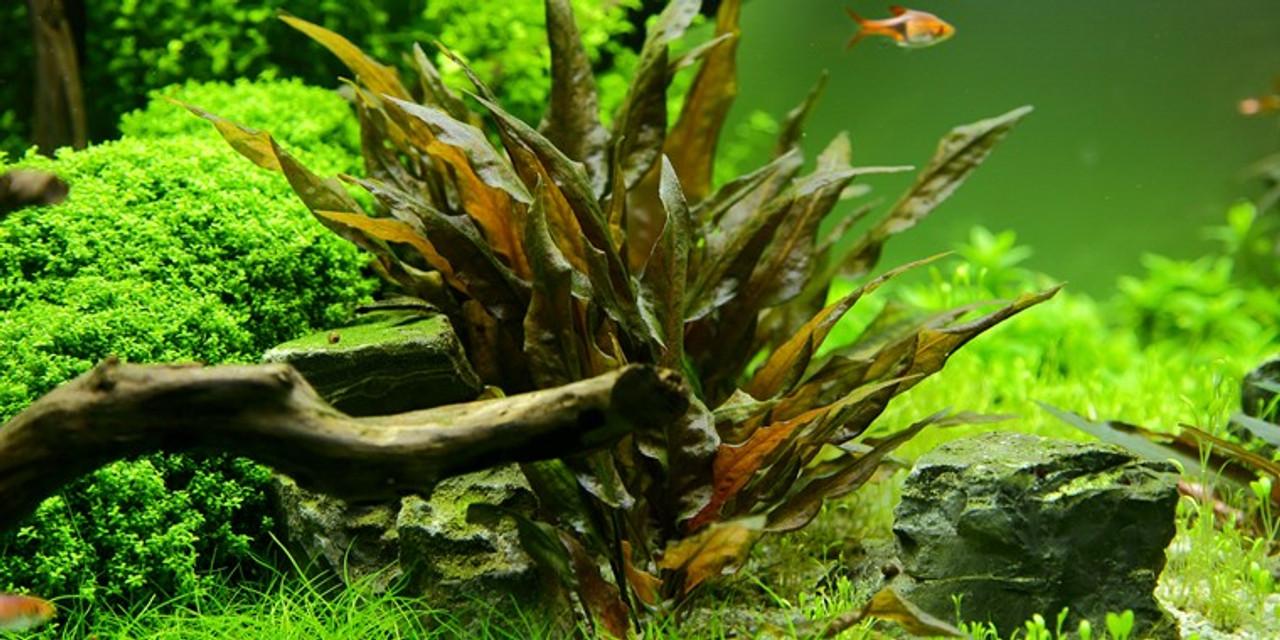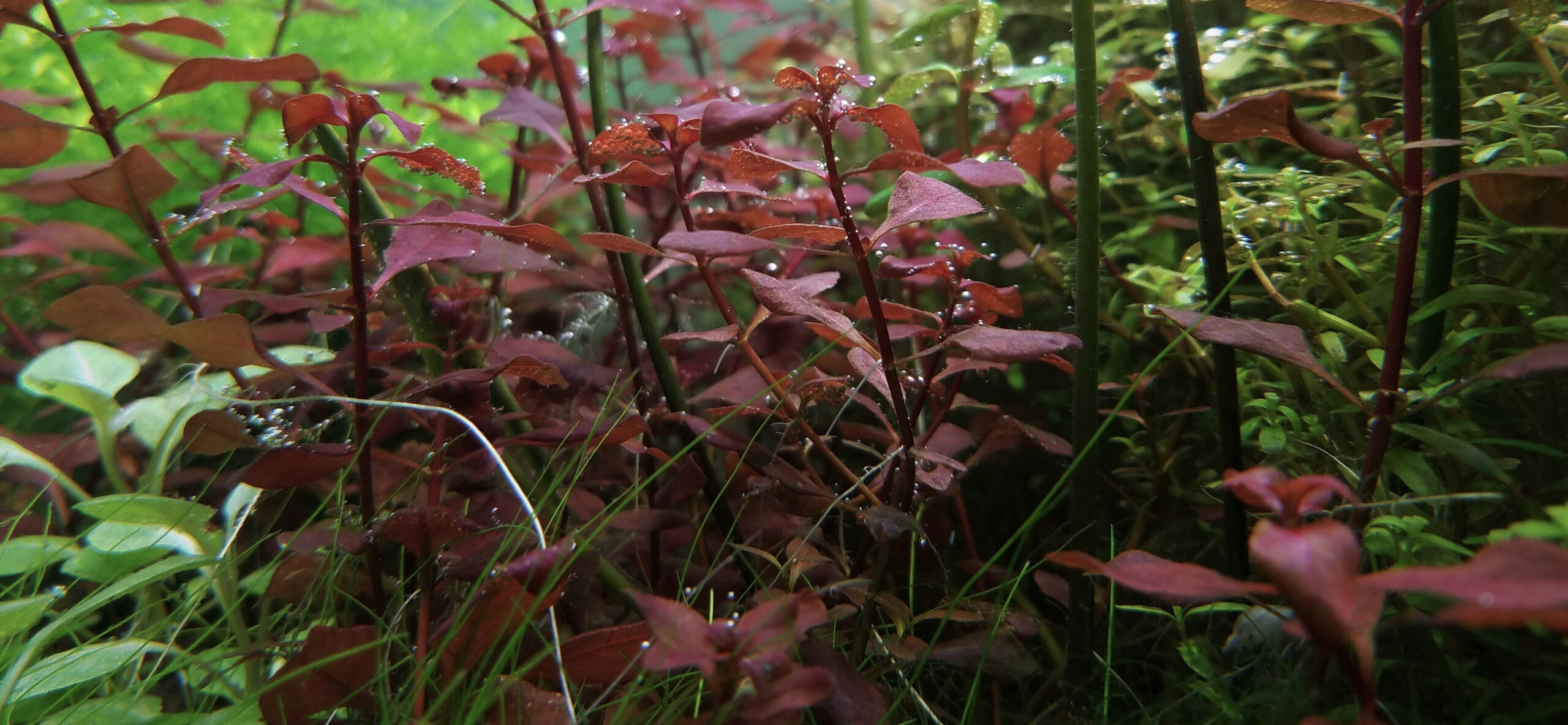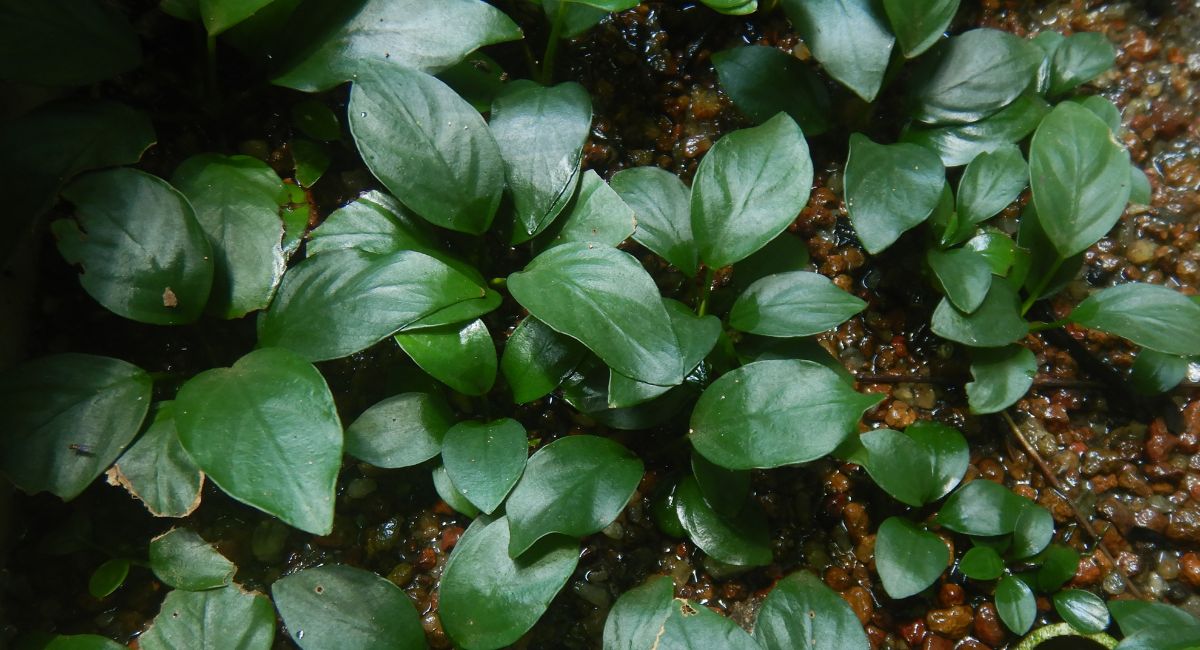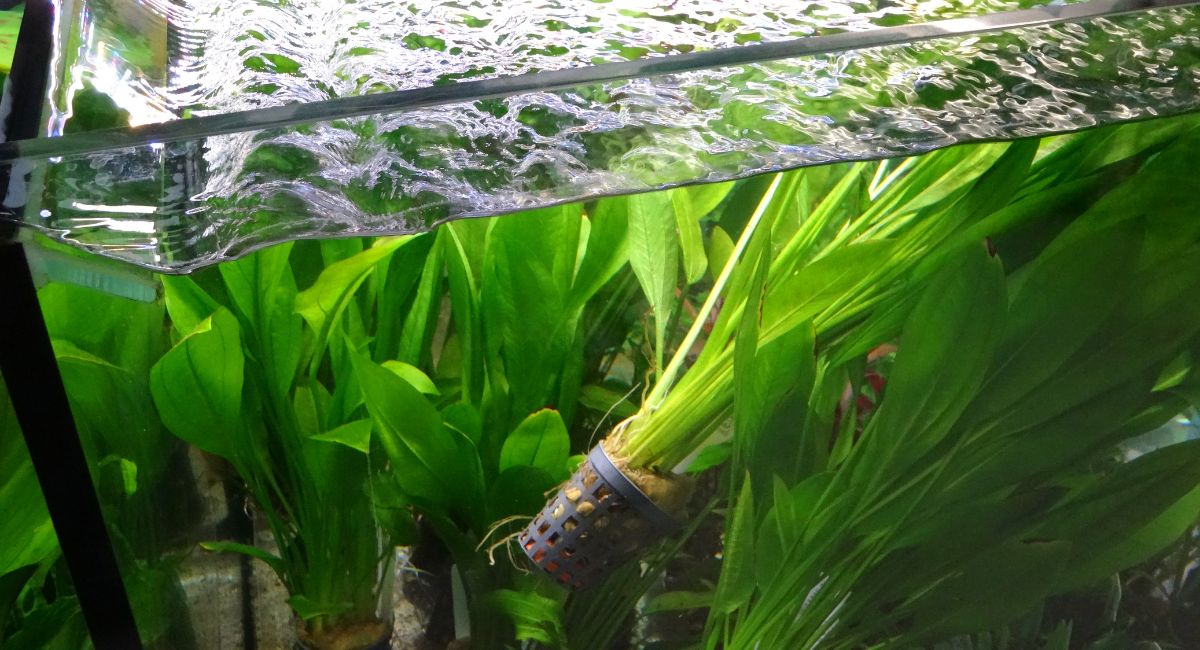Smartplantedaquarium.com participates in affiliate marketing programs. We may earn commissions on purchases made through our affiliate links. This doesn't affect our content or recommendations and we only recommend products we would put in our own tanks.
Transforming your aquarium into a lush aquatic haven not only provides a visually appealing experience but also nurtures a thriving ecosystem for your aquatic companions. Among the myriad of aquatic plants available, Utricularia Graminifolia stands out as a unique and captivating addition to any aquarium. Often referred to as “UG” in the aquarist community, this delicate and graceful species brings a touch of elegance and natural beauty to your underwater world.
In this comprehensive guide, we will delve into the intricacies of planting and caring for Utricularia Graminifolia in your aquarium. Whether you’re a seasoned aquarist or a newcomer to the world of aquatic plants, our step-by-step instructions will equip you with the knowledge and confidence to cultivate this extraordinary plant successfully.
Let’s explore the captivating aspects of Utricularia Graminifolia and learn the art of planting and maintaining this aquatic gem in your aquarium. Unlock the secrets to creating an enchanting underwater landscape and witness the wonders of UG as it enhances the beauty and health of your aquatic ecosystem.
Contents
- Overview of Utricularia Graminifolia
- Benefits of Keeping Utricularia Graminifolia in Aquariums
- Required Equipment and Supplies
- How to Plant Utricularia Graminifolia in Aquarium
- Mistakes to Avoid When Planting Utricularia Graminifolia
- How to Use Utricularia Graminifolia for Aquascaping
- Conclusion
- Frequently Asked Questions
- 1. What are the best companion plants for Utricularia graminifolia?
- 2. What are the best tank mates for Utricularia graminifolia?
- 3. How fast does Utricularia graminifolia grow?
- 4. How big does Utricularia graminifolia grow?
- 5. Is Utricularia graminifolia suitable for beginners?
- 6. Is Utricularia graminifolia suitable for a low-tech aquarium?
Overview of Utricularia Graminifolia
Utricularia Graminifolia, commonly known as “UG” or Grass-like Bladderwort, is a fascinating and sought-after aquatic plant that belongs to the carnivorous bladderwort family, Lentibulariaceae. Unlike most carnivorous plants that are terrestrial, Utricularia Graminifolia is an aquatic species that can thrive in submerged conditions, making it an excellent choice for aquarium enthusiasts looking to add a touch of uniqueness and beauty to their aquatic setups.
Description and Appearance
Utricularia Graminifolia is a small, herbaceous perennial plant with a graceful and delicate structure. Unlike many other aquarium plants, UG doesn’t have traditional roots; instead, it features a specialized root system comprising tiny bladder-like structures called “utricles.” These utricles serve as traps for small aquatic organisms, enabling the plant to supplement its nutrient intake by capturing and digesting tiny prey.
The plant’s leaves are thin, thread-like, and grow in dense tufts, creating a lush, grass-like appearance that resembles a miniature meadow beneath the water’s surface. Each leaf is relatively short, usually ranging from 2 to 3 centimeters in length, and exhibits a vibrant green hue, adding a touch of freshness to any aquarium setup.
When Utricularia Graminifolia enters its flowering phase, it produces small, dainty yellow flowers that emerge above the water’s surface on delicate stalks. However, it’s important to note that flowering is relatively rare in aquarium settings, as it often requires specific conditions and may not occur frequently.
Origin
Utricularia Graminifolia is native to the southeastern parts of Asia, where it can be found growing in various aquatic habitats, such as marshes, ponds, and slow-moving streams. Its natural distribution includes countries like Thailand, India, the Philippines, and other neighboring regions.
As UG gained popularity among aquarists for its ornamental value and unique growth habit, it was eventually introduced to the aquarium hobbyist community. Due to its popularity, it is now widely cultivated and propagated in aquariums all over the world, allowing aquarists to enjoy the beauty of this fascinating aquatic plant species in their own underwater landscapes.
Different Types of Utricularia Graminifolia
Within the Utricularia Graminifolia species, various regional variations and ecotypes can be found, each exhibiting subtle differences in appearance and growth patterns. While the core characteristics of UG remain consistent throughout these types, some variations might be seen in leaf coloration, size, or growth rate.
It’s worth noting that, despite these minor differences, all types of Utricularia Graminifolia share a common need for specific care and maintenance to thrive successfully in an aquarium environment.
Benefits of Keeping Utricularia Graminifolia in Aquariums
Keeping Utricularia Graminifolia in aquariums can bring numerous benefits to the aquatic environment and the overall well-being of the tank’s inhabitants. Here are some of the key advantages of having this unique plant in your aquarium:
| Benefits | Description |
|---|---|
| Aesthetically Pleasing Aquascape | Forms a lush carpet of grass-like leaves, enhancing the visual appeal of the aquarium. |
| Oxygen Production | Engages in photosynthesis, increasing oxygen levels and benefiting aquatic inhabitants. |
| Nutrient Uptake and Filtration | Efficiently absorbs excess nutrients, helping prevent algae overgrowth and water clarity. |
| Natural Habitat for Microorganisms | Creates a habitat for microorganisms and invertebrates, supplementing the food chain. |
| Habitat and Shelter for Fry | Provides hiding places for baby fish and shrimp, reducing predation and stress. |
| Alleviates Soil Erosion | Intertwining root system prevents soil erosion, especially useful in high-flow setups. |
| Low Maintenance | Requires minimal pruning and care, making it suitable for beginners and experts alike. |
| Natural Behavior Observation | Fascinating to watch the carnivorous behavior of bladders capturing and digesting prey. |
- Aesthetically Pleasing Aquascape: Utricularia Graminifolia forms a lush and vibrant carpet of grass-like leaves, creating a visually appealing aquascape. Its low-growing and dense growth habit adds depth and dimension to the aquarium, making it a popular choice for aquascaping enthusiasts. The carpet effect adds a touch of natural beauty, replicating the look of a well-maintained meadow within the aquatic environment.
- Oxygen Production: Like all aquatic plants, Utricularia Graminifolia engages in photosynthesis, converting carbon dioxide into oxygen during daylight hours. This oxygen production enhances the overall oxygen levels in the aquarium, benefiting fish, shrimp, and other aquatic inhabitants. Adequate oxygenation is crucial for the well-being of the aquarium’s fauna and helps maintain a balanced and healthy ecosystem.
- Nutrient Uptake and Filtration: UG is known to be an efficient nutrient absorber. By taking up excess nutrients such as nitrates, phosphates, and ammonia, it helps in reducing nutrient levels in the water. This nutrient uptake is especially beneficial for preventing algae overgrowth, promoting water clarity, and maintaining optimal water conditions.
- Natural Habitat for Microorganisms: The unique carnivorous nature of Utricularia Graminifolia, with its specialized bladders, creates a microhabitat that fosters a thriving population of microorganisms and small aquatic invertebrates. This creates a self-sustaining environment where tiny creatures serve as a supplementary food source for the fish and shrimp residing in the aquarium.
- Habitat and Shelter for Fry: The dense carpet created by UG provides an ideal hiding place and shelter for fry (baby fish and shrimp). It offers protection from potential predators, increasing their chances of survival and reducing stress on the fry population.
- Alleviates Soil Erosion: The delicate, intertwining root systems of Utricularia Graminifolia help bind the substrate together, preventing soil erosion in the aquarium. This is particularly beneficial in aquariums with high water flow or active burrowing fish.
- Low Maintenance: UG is considered a relatively low-maintenance plant, especially when compared to some other carpeting plants. Once established, it requires minimal pruning and upkeep, making it an excellent choice for both beginners and experienced aquarium enthusiasts.
- Natural Behavior Observation: Watching Utricularia Graminifolia’s unique carnivorous behavior can be an educational and fascinating experience. Observing the bladders capturing and digesting tiny prey can deepen one’s understanding of the complex interactions that occur within an aquarium ecosystem.
Required Equipment and Supplies
To successfully plant and maintain Utricularia Graminifolia in your aquarium, you’ll need a few essential equipment and supplies. Here’s a list of what you’ll require:
| Equipment and Supplies | Description |
|---|---|
| Aquarium | A suitable tank with proper lighting and water quality. |
| Substrate | Nutrient-rich, fine-grained substrate for rooting. |
| Aquarium Light | High-quality LED light for photosynthesis support. |
| CO2 System (optional) | Enhances growth in high-tech setups. |
| Liquid Fertilizers | Provides essential nutrients for healthy growth. |
| Aquarium Heater | Maintains temperature within the optimal range. |
| Filter | Keeps water clean and removes excess nutrients. |
| Aquarium Tweezers | For precise planting and maintenance. |
| Scissors | Trimming for shape and maintenance. |
| Water Conditioner | Removes harmful chemicals from tap water. |
| Aquarium Test Kits | Monitors water parameters for adjustments. |
| Aquarium Gravel Vacuum | For regular water changes and substrate cleaning. |
| Algae Scraper/Pad | Keeps the glass clean and free from algae. |
| Aquarium Net | Useful for catching and relocating fish or shrimp. |
- Aquarium: A suitable aquarium with adequate lighting and water parameters to support plant growth. Utricularia Graminifolia can thrive in both small and large aquariums, depending on your preference.
- Substrate: Choose a nutrient-rich substrate specifically designed for planted aquariums. UG requires a fine-grained substrate that allows its delicate roots to anchor firmly.
- Aquarium Light: Provide a high-quality aquarium light that delivers sufficient intensity and spectrum to support photosynthesis. LED lights with a color temperature between 6500K to 7000K are ideal for promoting healthy plant growth.
- CO2 System (optional): While Utricularia Graminifolia can grow without additional CO2 supplementation, providing a CO2 system can greatly enhance its growth and carpeting effect. It’s particularly beneficial in high-tech aquarium setups.
- Liquid Fertilizers: Use a comprehensive liquid fertilizer specifically formulated for aquatic plants. This ensures the plants receive essential nutrients like nitrogen, phosphorus, potassium, and trace elements for healthy growth.
- Aquarium Heater: Maintain the water temperature within the suitable range for your aquarium inhabitants. UG generally thrives in temperatures between 68°F to 82°F (20°C to 28°C).
- Filter: A good quality aquarium filter helps maintain water quality by removing debris and excess nutrients, ensuring a healthy environment for your aquatic plants and animals.
- Aquarium Tweezers and Scissors: These tools are essential for planting and trimming Utricularia Graminifolia. Tweezers help with precise placement, and scissors are useful for trimming to maintain the desired shape.
- Water Conditioner: Use a water conditioner to remove harmful chlorine and chloramine from tap water before adding it to the aquarium.
- Aquarium Test Kits: Test kits for measuring water parameters like pH, ammonia, nitrite, and nitrate levels are vital for monitoring the aquarium’s health and making necessary adjustments.
- Aquarium Gravel Vacuum: This tool helps with regular water changes and cleaning the substrate, preventing debris buildup and maintaining water quality.
- Algae Scraper/Pad: To keep the aquarium glass clean and free from algae growth.
- Aquarium Net: Useful for catching and relocating fish or shrimp if needed.
How to Plant Utricularia Graminifolia in Aquarium
Step 1: Preparing the Aquarium and Substrate
- Clean the Aquarium: Ensure the aquarium is clean and free from any debris or residues. Thoroughly rinse the tank, gravel, and any decorative items to avoid introducing contaminants that could hinder plant growth.
- Select the Substrate: Choose a fine-grained, nutrient-rich substrate specifically designed for planted aquariums. The substrate should be about 2 to 3 inches (5 to 7.5 cm) deep to allow sufficient anchoring for Utricularia Graminifolia’s delicate roots.
- Level the Substrate: Spread the substrate evenly across the aquarium’s bottom, creating a smooth and level surface. A slight slope towards the front of the tank can add depth to the aquascape.
- Add Water: Fill the aquarium with dechlorinated water to the desired level. Avoid disturbing the substrate while adding water to maintain its evenness.
Step 2: Planting Utricularia Graminifolia
- Prepare the Plants: Trim any damaged or excessively long roots from the Utricularia Graminifolia plant. Gently separate the plants into smaller portions, making it easier to plant them individually.
- Planting Technique: Use tweezers to plant the individual portions of Utricularia Graminifolia in the substrate. Press the roots gently into the substrate, ensuring they are securely anchored while leaving the fine leaves above the surface.
- Spacing and Density: Aim for a dense carpet effect by planting the UG portions close together, typically about 0.5 to 1 inch (1.25 to 2.5 cm) apart. This will encourage them to grow and form a lush carpet over time.
- Planting Order: Begin planting from the front of the aquarium and work your way towards the back. This way, you can easily reach all areas and maintain a visually appealing arrangement.
Step 3: Providing Optimal Conditions
- Lighting: Position the aquarium light at the appropriate height and set the duration for 8 to 10 hours a day. Utricularia Graminifolia requires moderate to high lighting for healthy growth.
- CO2 Supplementation (optional): If you have a high-tech setup, consider adding CO2 supplementation to enhance plant growth. This can significantly boost UG’s carpeting effect.
- Fertilization: Regularly add liquid fertilizers specifically formulated for aquatic plants. Follow the recommended dosing guidelines to ensure UG receives essential nutrients for robust growth.
- Water Parameters: Maintain stable water parameters within the recommended range for your aquarium’s inhabitants. UG thrives in slightly acidic to neutral pH (around 6.0 to 7.5) and moderately soft to moderately hard water.
Step 4: Maintenance and Growth
- Trimming: As Utricularia Graminifolia grows, trim any excessive growth or straggly parts to maintain a neat and compact carpet appearance. Use aquarium scissors for precise trimming.
- Water Changes: Perform regular water changes (20-30% every week) to prevent the buildup of excess nutrients and maintain water quality.
- Algae Control: Keep a watchful eye for algae growth and address any issues promptly. Manual removal and maintaining proper water conditions will help keep algae in check.
- Observation: Regularly observe the UG carpet for signs of health and growth. Healthy Utricularia Graminifolia will exhibit vibrant green coloration and form a dense, uniform carpet, enhancing the beauty of your aquarium.
Certainly! Here are three more steps for planting and maintaining Utricularia Graminifolia in your aquarium, each with four additional points:
Step 5: Water Care and Circulation
- Water Circulation: Ensure adequate water circulation within the aquarium. Proper water movement helps distribute nutrients and CO2 evenly, benefiting Utricularia Graminifolia’s growth and overall health.
- Avoid Stagnation: Prevent stagnant water areas by strategically placing the filter outlet and adjusting its flow. Stagnant areas may lead to the accumulation of debris and hinder plant growth.
- Water Quality: Regularly test water parameters and maintain ideal conditions for UG. Aim for ammonia and nitrite levels at zero and keep nitrate levels in check (ideally below 20 ppm).
- Temperature Stability: Maintain a stable water temperature within the recommended range. Drastic temperature fluctuations can stress the plants and disrupt their growth.
Step 6: Nutrient Management
- Balance Fertilization: Be cautious not to over-fertilize, as excess nutrients can lead to algae outbreaks. Adjust fertilization based on the plant’s growth and the overall health of the aquarium.
- Substrate Fertilizers: Consider using root tab fertilizers specifically designed for aquatic plants. These provide essential nutrients directly to the substrate and promote healthy root development.
- Supplementing Micronutrients: Some commercial fertilizers lack certain micronutrients essential for Utricularia Graminifolia’s growth. Consider adding trace element supplements to ensure complete nutrient coverage.
- Watch for Nutrient Deficiencies: Be vigilant for signs of nutrient deficiencies, such as yellowing leaves or stunted growth. Adjust fertilization or nutrient dosing accordingly.
Step 7: Algae Prevention and Control
- Light Duration: Keep a consistent light schedule to discourage algae growth. Avoid leaving the lights on for extended periods, as this can encourage algae to thrive.
- Light Intensity: Adjust the light intensity based on your aquarium’s specific needs. High light levels may lead to excessive algae growth, while too low light can hinder Utricularia Graminifolia’s growth.
- Algae-Eating Inhabitants: Introduce algae-eating aquatic species like snails, shrimp, or certain fish species (such as Siamese algae eaters or otocinclus) to help control algae naturally.
- Regular Maintenance: Perform routine maintenance tasks, including cleaning the glass, removing debris, and gently scrubbing any visible algae from hardscape and equipment.
Mistakes to Avoid When Planting Utricularia Graminifolia
Planting Utricularia Graminifolia in an aquarium requires careful attention to detail to ensure its successful establishment and growth. Here are some common mistakes to avoid when planting UG:
| Mistakes to Avoid | Description |
|---|---|
| Planting Too Deep | Avoid burying Utricularia Graminifolia too deep in the substrate, hindering root development. |
| Insufficient Lighting | Provide moderate to high lighting to support healthy growth and prevent weak, elongated stems. |
| Overcrowding and Spacing | Avoid planting too closely, as it can lead to shading and competition for light, affecting growth. |
| Neglecting CO2 and Nutrient Needs | Ensure adequate CO2 and nutrient supply to enhance growth and prevent deficiencies. |
| Skipping Quarantine | Always quarantine new plants to avoid introducing pests or algae into the aquarium. |
| Failing to Address Algae Promptly | Promptly address algae growth in the carpet to maintain plant health and appearance. |
| Ignoring Water Parameters | Monitor water quality and parameters regularly to ensure stable and suitable conditions. |
| Improper Trimming | Use sharp scissors and trim with care to avoid damaging the plant or leaving gaps in the carpet. |
| Over-Pruning | Gradually prune over time to prevent shocking the plant and disrupting growth. |
| Using Copper-based Products | Avoid copper-based products in tanks with Utricularia Graminifolia, as it’s sensitive to copper. |
- Planting Too Deep: Avoid planting Utricularia Graminifolia too deep in the substrate. Its delicate roots need to be in direct contact with the substrate surface for optimal growth. Planting too deep may hinder root development and weaken the plant.
- Insufficient Lighting: UG requires moderate to high lighting for healthy growth and carpeting effect. Inadequate lighting can lead to weak, elongated growth and prevent the carpet from forming as desired. Ensure proper lighting intensity and duration to support its photosynthesis needs.
- Overcrowding and Spacing: While aiming for a dense carpet effect, avoid overcrowding the Utricularia Graminifolia portions too closely. Insufficient spacing can lead to shading and competition for light, affecting growth and carpet uniformity. Plant the portions at an appropriate distance to encourage even coverage.
- Neglecting CO2 and Nutrient Needs: Although UG can survive without additional CO2 supplementation, providing it with CO2 can significantly enhance its growth and carpeting. Similarly, neglecting essential nutrient requirements can lead to stunted growth and nutrient deficiencies. Be mindful of providing the right amount of CO2 and nutrients.
- Skipping Quarantine: Introducing Utricularia Graminifolia or any other aquatic plant without proper quarantine may introduce pests, snails, or algae into the aquarium. Always quarantine new plants to avoid potential problems.
- Failing to Address Algae Promptly: If algae appear in the UG carpet, address the issue promptly. Ignoring algae growth can harm the plant’s health and hinder its carpeting effect. Take appropriate measures, such as improving water quality or introducing algae-eating species, to control algae growth.
- Ignoring Water Parameters: UG thrives within specific water parameters. Neglecting water quality and parameters can stress the plant and hinder its growth. Monitor water conditions regularly and make necessary adjustments to maintain stable and suitable conditions.
- Improper Trimming: While trimming is essential to maintain the carpet’s shape, improper trimming can damage the plant or leave gaps in the carpet. Use sharp, clean scissors and trim with care to achieve a neat appearance.
- Over-Pruning: Excessive pruning or cutting too much of the Utricularia Graminifolia at once can shock the plant and disrupt its growth. Gradually prune over time, allowing the plant to adjust to changes.
- Using Copper-based Products: UG is sensitive to copper, commonly found in some aquarium medications and algaecides. Avoid using copper-based products in tanks with Utricularia Graminifolia, as it can harm the plant.
How to Use Utricularia Graminifolia for Aquascaping
Using Utricularia Graminifolia (UG) for aquascaping can transform your aquarium into a captivating and visually stunning underwater landscape. Here are few suggestions on how to effectively use UG for aquascaping:
- Decide on the layout and design you want to achieve. Consider factors such as the size and shape of the aquarium, the placement of hardscape elements (e.g., rocks and driftwood), and the arrangement of other plants.
- Take into account the lighting conditions and water parameters required for UG and other selected plants and adjust your design accordingly.
- Clean the aquarium thoroughly and ensure it is free from any contaminants.
- Choose a fine-grained, nutrient-rich substrate specifically designed for planted aquariums. Ensure it is about 2 to 3 inches (5 to 7.5 cm) deep to allow sufficient anchoring for Utricularia Graminifolia’s delicate roots.
- Ensure your aquarium receives moderate to high lighting to support Utricularia Graminifolia’s growth and maintain the carpeting effect.
- Consider supplementing CO2 to enhance UG’s growth, especially in high-tech setups.
- Perform regular maintenance tasks, such as trimming UG to maintain its carpet shape and removing any debris or algae.
- Monitor water quality and parameters regularly to ensure stable and suitable conditions for UG and other plants.
- Continuously monitor and fine-tune your aquascape as the plants grow and fill in the carpet. Regularly trim and adjust the layout to achieve the desired look.
- Be patient, as UG is a slow-growing plant, and the carpet effect may take time to fully develop. Regular care and attention will lead to a flourishing and visually appealing Utricularia Graminifolia carpet in your aquascape.
Conclusion
In conclusion, planting Utricularia Graminifolia in your aquarium can bring a touch of natural beauty and intrigue to your aquatic landscape. As a low-growing carpeting plant, UG offers a unique and captivating appearance, resembling a lush meadow beneath the water’s surface. While the process of cultivating this plant may require some patience and attention to detail, the results are well worth the effort.
To successfully plant Utricularia Graminifolia, careful preparation of the aquarium and substrate is essential. Providing the right lighting, CO2 supplementation (if applicable), and nutrient-rich substrate sets the foundation for its healthy growth. Patience is key as UG establishes its root system and begins to spread, forming a dense and visually stunning carpet over time.
By following the guidelines and tips provided in this article, you can confidently embark on your UG planting journey. As you watch your aquarium transform into a mesmerizing underwater meadow, you’ll be rewarded with the beauty of Utricularia Graminifolia and the joy of a thriving aquatic ecosystem right in your own home.
Frequently Asked Questions
1. What are the best companion plants for Utricularia graminifolia?
Utricularia graminifolia, also known as “Dwarf Grass” or “Graminifolia,” is a delicate and unique foreground plant that pairs well with other low-growing and non-competitive aquatic plants. Some suitable companion plants include Java Moss, Anubias Nana, Cryptocoryne parva, Dwarf Sagittaria, Eleocharis.
2. What are the best tank mates for Utricularia graminifolia?
Due to its delicate nature, Utricularia graminifolia is best suited for aquariums with small, peaceful fish and invertebrates that won’t disturb or uproot its delicate foliage. Some suitable tank mates include:
1) Small schooling fish like Neon Tetras or Ember Tetras.
2) Shrimp species like Cherry Shrimp or Ghost Shrimp.
3) Snails such as Nerite Snails or Malaysian Trumpet Snails.
3. How fast does Utricularia graminifolia grow?
Utricularia graminifolia is a slow-growing plant compared to many other aquarium plants. Under ideal conditions, it may take several weeks to a few months for it to establish and form a dense carpet. Patience and consistent care are essential for successful cultivation.
4. How big does Utricularia graminifolia grow?
Utricularia graminifolia stays relatively small, with its grass-like leaves reaching a height of about 2 to 4 inches (5 to 10 cm). It forms a low and dense carpet in the aquarium, creating a lush foreground.
5. Is Utricularia graminifolia suitable for beginners?
Utricularia graminifolia is not the easiest plant for beginners due to its slow growth and specific care requirements. Its delicate nature demands attention to detail in maintaining water parameters and lighting conditions. Beginners might find it challenging to establish and maintain a healthy carpet of Utricularia graminifolia without some prior experience in aquatic plant care.
6. Is Utricularia graminifolia suitable for a low-tech aquarium?
Utricularia graminifolia is not well-suited for a low-tech aquarium setup. It typically requires high-intensity lighting and a CO2 injection system to thrive. Without sufficient light and CO2, it may struggle to grow and might be outcompeted by algae or other fast-growing plants. As a result, it is better suited for advanced aquarists or hobbyists familiar with high-tech setups.
